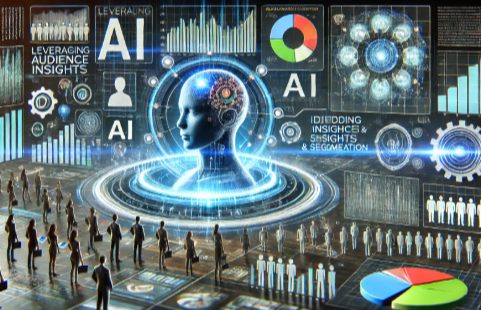How AI Enhances Audience Targeting for Smarter Campaigns

In the fast-evolving landscape of digital marketing, reaching the right audience with the right message is a strategic imperative. Artificial intelligence (AI) has redefined audience targeting, transforming campaigns from broad, one-size-fits-all approaches to highly precise, data-driven initiatives. By leveraging machine learning, predictive analytics, and real-time data processing, AI enables businesses to understand their audiences deeply and engage them effectively. This article explores how AI enhances audience targeting, offering a blueprint for crafting smarter campaigns that resonate and deliver results.
Unlocking Deep Consumer Insights
AI’s ability to process vast amounts of data sets it apart as a game-changer in audience targeting. It goes beyond traditional metrics like age or location, diving into behavioral patterns, preferences, and even emotional triggers. By analyzing data from sources like purchase histories, website interactions, and social media activity on platforms like X, AI builds comprehensive profiles of potential customers.
For example, a pet supply brand might use AI to identify dog owners who frequently search for organic pet food or engage with pet care tips online. This granular understanding allows the brand to craft messages that align with specific customer needs, such as promoting a new line of eco-friendly treats. By uncovering what drives consumer behavior, AI ensures campaigns are rooted in insight rather than assumption.
Creating Dynamic Audience Segments
Effective targeting hinges on segmentation, and AI excels at dividing audiences into meaningful, actionable groups. Unlike static demographic categories, AI-driven segmentation uses real-time data to create fluid clusters based on behavior, intent, and context. These segments evolve as consumer actions change, ensuring relevance.
Consider a travel company planning a summer campaign. AI might categorize its audience into segments like “budget backpackers,” “luxury travelers,” or “family vacationers,” based on search patterns and booking histories. Each group receives tailored content—budget tips for backpackers, exclusive resort offers for luxury seekers. This precision reduces wasted ad spend and increases engagement by delivering messages that feel personal and relevant.
Personalizing Experiences at Every Touchpoint
Personalization is the cornerstone of modern marketing, and AI makes it scalable. By analyzing individual data points, AI tailors content—from ad copy to product recommendations—to match each customer’s preferences and journey stage. This creates a sense of connection that drives engagement.
Take an e-commerce fashion retailer as an example. AI might notice a customer frequently views athletic wear and prefers neutral colors. The system could then display ads for black running shoes or suggest a matching workout outfit during checkout. Such tailored interactions, enabled by AI, make customers feel valued, boosting the likelihood of conversions and fostering brand affinity.
Optimizing Delivery for Maximum Impact
AI doesn’t just identify who to target—it determines how and when to reach them. Through predictive analytics, AI identifies the optimal channels, times, and formats for engaging specific audiences. This real-time optimization ensures campaigns land with precision, adapting to shifting consumer behaviors.
For instance, a coffee chain might use AI to target morning commuters with ads for a new latte. The system could detect that this audience is most active on mobile devices during early hours and prefers short video content. AI then schedules video ads on platforms like X to run at 7 a.m., maximizing visibility and clicks. This dynamic approach ensures campaigns stay agile and effective, even in a fast-changing digital environment.
Anticipating Needs with Predictive Analytics
Predictive analytics, a powerful AI capability, forecasts future consumer actions based on historical and real-time data. This allows businesses to anticipate customer needs and act proactively, creating seamless experiences that guide audiences toward action.
Imagine a subscription-based meal kit service. AI might predict which customers are likely to churn based on declining order frequency or lack of engagement with promotional emails. The company could then send a personalized discount or a new recipe suggestion to rekindle interest. By addressing needs before they’re explicitly stated, AI-driven campaigns build trust and keep customers engaged throughout their journey.
See Also: bookkeeping techniques for businesses
Navigating Ethical and Practical Challenges
While AI enhances targeting, it also raises challenges that demand careful consideration. Privacy is a top concern, as consumers expect transparency about data usage. Businesses must comply with regulations like GDPR or CCPA, ensuring clear communication and consent mechanisms. Over-targeting is another risk—focusing too narrowly on specific segments can exclude potential customers. A balanced approach, blending AI precision with broader creative strategies, mitigates this.
For example, a skincare brand might use AI to target young adults with acne concerns but should also run inclusive campaigns to appeal to older demographics seeking anti-aging products. Ethical AI use, rooted in transparency and fairness, not only builds consumer trust but also ensures campaigns remain adaptable to diverse audiences.
Measuring and Refining Campaign Performance
AI’s value extends beyond campaign execution to performance analysis. By tracking metrics like engagement rates, conversions, and return on ad spend, AI provides actionable insights for continuous improvement. This iterative process allows businesses to refine targeting strategies in real time.
A tech gadget retailer, for instance, might discover through AI analytics that ads for wireless earbuds perform better among urban professionals than rural hobbyists. The retailer can then shift budget toward the higher-performing segment, optimizing results. This data-driven feedback loop ensures campaigns evolve with audience preferences, driving efficiency and impact.
Driving Loyalty Through Targeted Retention
The endgame of AI audience targeting isn’t just acquisition—it’s fostering loyalty. AI analyzes post-purchase behavior to identify opportunities for re-engagement, turning one-time buyers into repeat customers and advocates. Personalized follow-ups, loyalty rewards, or tailored recommendations keep customers connected.
Picture a bookstore using AI to track reading habits. If a customer frequently buys mystery novels, AI might send a curated list of new releases in that genre or invite them to an author event. These efforts strengthen the customer relationship, encouraging reviews or shares on platforms like X, which amplify brand reach organically.
Transforming Campaigns with AI Precision
AI audience targeting revolutionizes how businesses connect with consumers, enabling smarter, more effective campaigns. By unlocking deep insights, creating dynamic segments, personalizing experiences, and optimizing delivery, AI ensures messages reach the right viewers with precision. Navigating challenges like privacy and over-targeting with ethical practices further enhances its impact. From sparking awareness to driving loyalty, AI empowers brands to craft campaigns that not only resonate but also build lasting relationships, redefining the future of marketing in a data-driven world.

